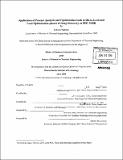| dc.contributor.advisor | J. Christopher Love and Roy Welsch. | en_US |
| dc.contributor.author | Yglesias, Tatiana | en_US |
| dc.contributor.other | Leaders for Global Operations Program. | en_US |
| dc.date.accessioned | 2010-11-08T17:40:17Z | |
| dc.date.available | 2010-11-08T17:40:17Z | |
| dc.date.copyright | 2010 | en_US |
| dc.date.issued | 2010 | en_US |
| dc.identifier.uri | http://hdl.handle.net/1721.1/59882 | |
| dc.description | Thesis (S.M.)--Massachusetts Institute of Technology, Dept. of Chemical Engineering; and, (M.B.A.)--Massachusetts Institute of Technology, Sloan School of Management; in conjunction with the Leaders for Global Operations Program at MIT, 2010. | en_US |
| dc.description | Cataloged from PDF version of thesis. | en_US |
| dc.description | Includes bibliographical references (p. 82-84). | en_US |
| dc.description.abstract | Given that research is based on innovation, it has been believed that its activities can only be optimized with equipment upgrade, increment in personnel scientific knowledge, development of new analytical software and/or changing the areas of study. After realizing the limited results achieved with these approaches, lab representatives started to notice the opportunity of introducing process optimization tools, such as Lean and Six Sigma, which showed success in manufacturing environments,. This project analyzes the interrelation between process and results, providing a clear explanation of cause and effect conditions, and a concise list of areas for improvement. Specifically, the document defines a measurement system using process maps and key performance indicators (KPIs). With this, the document describes the current state through historic trends, provides a complete data and root cause analysis for current state description, and provides a process capability study for the available indicators. Implementation of the steps mentioned above show how focus in lab turnaround times have been deviating attention from more impactful improvements, which can greatly affect overall drug discovery duration. Also, the analysis identifies that constant technology changes caused constant adaptation of process procedures, which generated non-value added activities. These non-value added activities today occupy about 50% of a lab associate's time. Lastly, historic data evaluation shows that root cause statistical analysis is limited by the presence of a combination of special and common cause variations. Some of the project recommendations include: incorporation of chemist's knowledge about compound potency, integration of equipment and software information, change in booking system, incorporation of assay and plate criteria, definition of standard procedures for specific activities, and integration of assay development and data submission tools. Overall, these changes can lead to a 50% reduction in the profiling times greater than 60 days, decrease of 62% and 60% in Compound Manager (CM) and Compound Profiler (CP) non-value added times respectively, 30% decrease in CM and CP total duration per assay plate, and increase in profiling time stability and predictability. Despite the fact that timing and scale of available resources will impact the realized benefits, the proposed framework gives EPP the opportunity to assess the improvements by their effect and alignment with goals. | en_US |
| dc.description.statementofresponsibility | by Tatiana Yglesias. | en_US |
| dc.format.extent | 102 p. | en_US |
| dc.language.iso | eng | en_US |
| dc.publisher | Massachusetts Institute of Technology | en_US |
| dc.rights | M.I.T. theses are protected by
copyright. They may be viewed from this source for any purpose, but
reproduction or distribution in any format is prohibited without written
permission. See provided URL for inquiries about permission. | en_US |
| dc.rights.uri | http://dspace.mit.edu/handle/1721.1/7582 | en_US |
| dc.subject | Chemical Engineering. | en_US |
| dc.subject | Sloan School of Management. | en_US |
| dc.subject | Leaders for Global Operations Program. | en_US |
| dc.title | Application of process analysis and optimization tools in hit-to-lead and lead optimization phases of drug discovery at EPP, NIBR | en_US |
| dc.type | Thesis | en_US |
| dc.description.degree | M.B.A. | en_US |
| dc.description.degree | S.M. | en_US |
| dc.contributor.department | Leaders for Global Operations Program at MIT | en_US |
| dc.contributor.department | Massachusetts Institute of Technology. Department of Chemical Engineering | |
| dc.contributor.department | Sloan School of Management | |
| dc.identifier.oclc | 673625335 | en_US |
